SCISSION III - HISTORY: AS WE KNOW IT
Evolution is any change across successive generations in the heritable
characteristics of biological populations. Evolutionary processes give
rise to diversity at every level of biological organisation, including
species, individual organisms and molecules such as DNA and proteins.
'The whole vital process of the
earth takes place so gradually and in
periods of time which are so immense compared with the length of our
life, that these changes are not observed'; Aristotle, Treatise
on
Meteorology1|.'
Authors Hall and Hallgrímsson go on to explain, 'Although in the
traditional view, Darwin could not deal with the problem of the long
geological periods of time needed for life to evolve, he did made [sic] some calculations
based on rates of erosion that demonstrated the enormity of geological
time2|.'
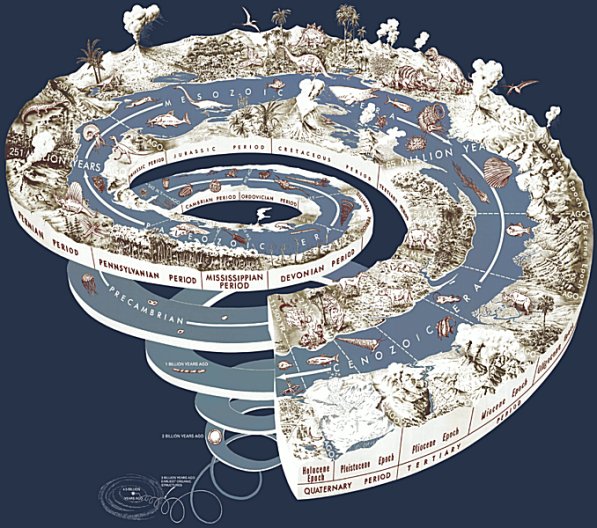
Graphical representation
of Earth's geological
history as a spiral
Joseph Graham, William
Newman, and John Stacy,
2008
United States Geological
Survey; Available online at
http://pubs.usgs.gov/gip/2008/58/
For [hundreds of] millions of
years human-like kind evolved and
survived as 'hunter-gatherers'. This implies a family's daily
subsistence on what it could find to eat and, as often as not, where it
would spend the night as it moved its foraging from place to place. The
environment around him was man's greatest support, and his greatest
danger. This condition comprises the huge bulk of 'human history'.
According to current thought, humans remained hunter-gatherers,
clinging to a perilous daily subsistence, until approximately 10,000
years ago [approximately 8,000 BCE.] Even after this date, much of
human activity was limited to hunter-gatherer status while the new
technology of 'agriculture' slowly grew across the face of the globe.
According to the modern Darwinian scenario, during these vast eons of
time man slowly became
smarter and smarter. Perhaps this laborious
process had an accelerating component built in, but even that started
from such primitive origins so long ago that a normal human life would
likely see little or no change. First came the opposable thumb, then
crude clubs and after untold ages we find evidence of primitive stone
tools.
Darwinian philosophy assures us this scenario describes the complete
history of human-kind: a slow incredibly long progress towards one
small improvement after another. Certainly there are mountains of
evidence to support this line of thinking. Is there any school child
today that has heard otherwise?
During the modern era of archaeology - since about 1800 - some contrary
evidence difficult to explain has cropped up here and there, but it has
not been allowed to challenge the overwhelming consensus of slowly
tedious progress over centuries as well as over ages.
One example of a problem that presented itself was the appearance of
'civilization', long believed to have been born in Sumer in
Mesopotamia, between the Tigris and Euphrates Rivers. 'City-states'
arose there in the fourth millennium BCE [around 3,500]; written
language first appeared there about 3,000 BCE.
Why did this present a problem to evolutionists and their
'slow-development' theory? Simply because there was no precedent for
any of it. Supposedly hunter-gatherers had somewhere along the line
[since 8,000 BCE] developed a successful form of agriculture that
allowed individuals to specialize in skills not directly connected to
growing and harvesting food.
But what skills developed! Sumer explodes out of the desert sands with
a highly organized social structure: civil government and taxes, roads
and drainage, law enforcement, a regulated system of barter and
currency, contracts, medical professionals including doctors and
pharmacies, urban development... on and on. Obviously this would appear
to be a sudden explosion and not a slow evolutionary process.
Quickly on the heels of the Mesopotamian explosion came Egypt about
3,300 BCE3|,
and almost concurrently the Harappan civilization of the
Indus Valley4|, all
extremely complex social structures. This anomaly
just remained critically unexplored and unexplained by the 'experts'
for more than a century, and remains poorly explained today.
One curious facet of this rapid development was formation of complex
religious thought and along with that a calendric system to define the
exact length and seasons of the year. While the annual solar
calculation of the Roman calendar at the time of Christ was still off
by at least a quarter of a day, the Mayans
of Meso-America had
calculated the solar year as 365.2422 days5|;
the modern calculation
[2000] is 365.242189. The Maya left no evidence of possessing
telescopes or any other optical technologies.
The Maya also recorded the planetary cycles of Venus6|,
predicted eclipses, and, according to some, observed the
'great rift' in the
Milky Way Galaxy7|.
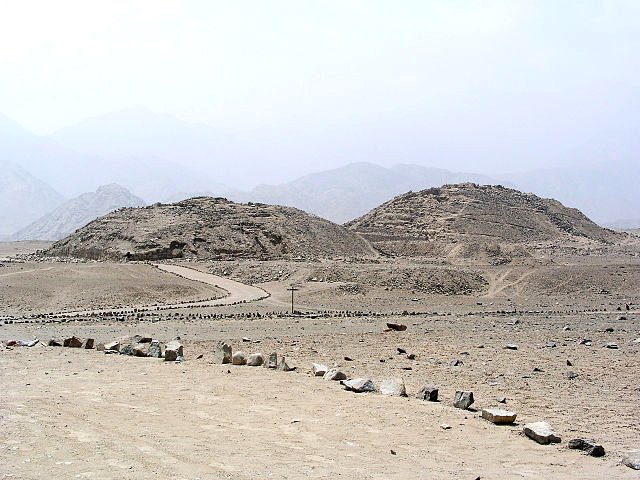
Pyramids at Caral in
the Supe Valley of
Peru's arid Pacific
coast region -
approximately 100
miles north of Lima.
Photograph taken in
August, 2004 by
Hĺkan Svensson Xauxa
Pyramids have been discovered in the Andean Altiplano of Peru that are
believed to possibly date to 3,000 BCE. The city of Caral in the Supe
Valley is
considered one of the earliest urban developments of the 'New World',
dating to at least 2,600 BCE8|.
Some Chaldean astronomical calculations proposed that the planets
circled around the Sun, predicted eclipses [the Saros Cycle], and used
a somewhat complicated lunisolar calendar, whereby the length of the
lunations and the solar year varied creating a 19-year calendar cycle.
It has been surmised, however, that the Babylonian / Chaldeans had
calculated the sidereal year to be 365.258 days, an error of about 2
minutes for the latter part of the fourth century BCE9|.
Some scholars
believe that their astronomical calculations implied knowledge that the
world was a globe, not flat.
The Greek astronomer Hipparchus extrapolated data from the Chaldean
calculations and identified precession; Precession is the process
whereby the polar axis of the earth's rotation slowly inscribes a
circle among the distant band of fixed stars [much as a spinning top
wobbles as it slows down]; the
complete precessional cycle consumes
approximately 26,000 years before the 'polar star' returns to its
original designation10|.
The Egyptians are believed to have borrowed their calendar from the
Chaldean / Babylonian records. It has become well known that these
ancient cultures were capable of detailed observations and complex
mathematical calculations that yielded reasonable accurate astronomical
data.
All of these cultures were able to construct lasting megalithic
monuments that used the cosmic data to align their structures. This has
led to a fairly new discipline within the study of archaeology:
archeoastronomy. R.M. Sinclair11| has
defined archeoastronomy as the
study of how people in the past 'have understood the phenomena in the
sky, how they used phenomena in the sky, and what role the sky played
in their cultures.' This does not necessarily presuppose that their
astronomical observations align with our present measurements, but that
they were making and using such observations is becoming increasingly
apparent.
Perhaps the most obvious example is the three pyramids on the Giza
Plateau in Egypt. The famous Egyptologist Flinders Petrie
[1853-1942]
pointed out that the Great Pyramid was perhaps the most accurately
north-facing structure in the world until recent times12|. In
more
recent times it has been proposed that the three pyramids are linearly
aligned the same as the three stars of the constellation Orion's
belt13|.
The proposed date of the building of the Great Pyramid is
about 2550 BCE.

What then about the site of the mound of Maeshowe on Mainland Orkney,
Scotland? It is estimated to date to about 3,000 BCE. A Neolithic
chambered cairn, the entrance
passage is aligned with the central chamber in such a way that the
midwinter sun shines a beam of light directly onto the back wall of the
central chamber. Other alignments combining natural hilly slopes and
standing stones have led one expert observer to state, 'Maeshowe is
thus an extremely sophisticated calendar site which must have been
positioned carefully in order to use the horizon foresights in the ways
described14|.'
Another famous megalithic site is, of course, Stonehenge. The first
constructions at the site probably were started about 3,100 BCE. Many
astronomical alignments, solar and lunar, have been proposed for the
various building stages of Stonehenge15|.
Originally archaeologists
were prone to describe the building of the huge megalithic complex as a
means for farmers to ascertain the best times for planting and
harvesting. Even to this author as a young untrained reader such a
scenario seemed preposterous. Would farmers have so much spare time on
their hands as to spend hundreds of years transporting and lifting huge
blocks of stone, while surveying the alignments for accurate
astronomical determination of the seasons? While the purpose of
Stonehenge is still in controversy, it appears the farmers have finally
been allowed to return to their plowing.
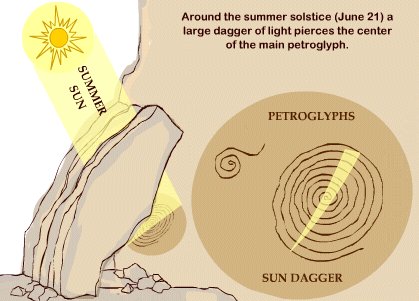
Diagrammatical representation
of the Chaco Canon 'Sun
Dagger' petroglyph.
Diagram obtained at
http://peakoil.com/forums/ancient-archetecture-t63815-90.html
Even at the site of the Pueblo culture in Chaco Canyon we find
astronomical alignments, and a possible allusion to the supernova that
created the Crab Nebula in a petroglyph located at Peńasco Blanco [see
previous scission.] The recently publicized 'Sun Dagger' at Fajada
Butte is formed by three stones leaning against the wall of the butte
in front of a spiral petroglyph. It is claimed to mark the solstices,
equinoxes and the lunar stand-stills of the 18.6 year cycle of the
moon. Various structural sites and connecting roads are believed also
to be laid out on astronomically important angles16|.
What we can deduce from these impressive scientific efforts of our
ancestors all over the world during the age of recorded history is that
they were perhaps nearly as smart as today's humans - and a lot more
scientifically capable than the average person in the twenty-first
century.
History: As We Are Learning
It
Thus we see that a reasonably advanced and organized agriculture
supports a more technically specialized cultural community. We saw
above that historians date the beginning of agriculture around 8,000
BCE. Some of the civilizations that have emerged on the historical
stage were mentioned above.
Prior to advanced agriculture humankind survived by being
hunter-gatherers. The Paleolithic, or Early Stone Age, dates from about
3 million years ago to as late as 10,000 BCE [varying a bit from
location to location.] The Mesolithic, or Middle Stone Age is somewhat
generally dated from 20,000 BCE to 9,500 BCE, especially in Europe. The
Neolithic, or New Stone Age, somewhat ambiguously overlaps the
Mesolithic dates but extends from about 10,500 to approximately 4,500
BCE.

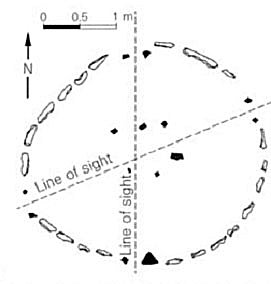
Graphics of location and
layout of Nabta Playa
pre-historic site obtained at
http://jordynsummers.blogspot.com/2011/01/nabta-playa-egypt.html
For more information
see Wikipedia
Consider Nabta Playa. Sometime
between 10,000 and 8,000 BCE people
began to construct an organized culture with large villages believed to
be based around domestication of livestock. It is located in what is
now the Nubian Desert 800 kilometers south of modern day Cairo, about
100 kilometers west of Abu Simbel in southern Egypt. At that time the
region experienced a much wetter climate.
Dating to at least 8,000 BCE evidence appears of large organized
settlements depending on deep wells for year-round farming and
pastorage17|. Not only does it appear
that they were domesticating wild
cattle and sheep, but certainly by the late seventh millennium they
were importing goats and sheep from
southwest Asia. Early settlements
in the area can be dated as early as 11,000 BCE.
Between 6,500 and 4,000 BCE a number of megalithic structures were
erected in the area. One circle of stones is considered to be a
calendar. Astrophysicist Thomas G. Brophy identifies a line of three
stones within the circle as mirroring the belt of the constellation of
Orion18|.
He claims three other stones within the circle outline the
head and shoulders of Orion as they appeared between 6,400 and 4,900
BCE and at precessional opposition.
The circle is made of relatively smaller stones, but there are
megalithic stones positioned nearby. Brophy estimates the alignment of
the megalithic stones with the circle could point to a date of
approximately 6270 BCE19|.
Some of Brophy's dates have been challenged
by as much as 1,500 years.
It is more widely accepted that the megalithic alignments corresponded
to the summer and winter solstices. The area is believed to have become
the focus of a 'regional ceremonial center' around 6,100 to 5,600 BCE.
There is evidence of large numbers of sacrificial cattle bones
scattered about the area.
Notwithstanding, the astronomical and mathematical expertise required
to calculate and align such structures must be considered impressive.
While the motivation given for such activity is often given as
religious, as it was originally speculated it was for the convenience
of farmers determining the seasons, some
hypothesize that the ancients
were trying to predict widespread catastrophes such as floods, climate
anomalies such as droughts and even cosmic events.
In southeast Turkey is a site dating to about 10,000 BCE that staggers
the imaginative skills of scholars. On a long mountain ridge 15 km
northeast of the town of Şanlıurfa, Turkey stands the recent find known
as Göbekli Tepe. It is
apparently a huge megalithic ceremonial center
dating to the Neolithic period.

This is an artist's rendering
of the
potentially expanded site of Göbekli
Tepe; geophysical surveys have
found 20 of these circles with more
than 200 pillars weighing up to 20
tons each. 4 circles have so far been
uncovered
The site's homepage is in German;
English information can be found
at Wikipedia
Archaeologists say it was built by a society of hunter-gatherers. The
hilltop location apparently holds about 20 circular stone structures,
four of which have been excavated. The center of each circle contains
two massive 'T-shaped' limestone pillars with others distributed about
the circumference. The pillars weigh between 10–20 metric tons. One
pillar still in the quarry about 1,000 feet away weighs 50 tons.
There is a developed village settlement nearby, Nevalı Çori, which
dates from the second half of the ninth millennium to well into the
tenth millennium BCE. The site is classified 'pre-pottery Neolithic'
due to fired ceramic figurines, supposedly of religious use, in the
absence of similarly fired pottery.
The building of the ceremonial site 'must have required a staggering
amount of manpower and labor20|.'
The circles vary from 30 to 100 feet
across. Many of the pillars have carved relief figures of animals - a
great variety of animals - a few unknown today. Some observers have
even pointed out the proximity of Mount Ararat and wondered about some
association with the
aftermath of the flood of Noah.
Apparently the people who built and utilized this site abandoned it
abruptly, and opted to bury the whole huge shrine in the sands. No
definite reason has been offered for such a surprising outcome.
A number of flint tools are found at the site. We are told that these
Neolithic hunter-gatherers used these flint tools to carve the huge
T-shaped pillars and the animal reliefs carved upon them.
Archaeologists point to stratification layers at the site and surmise
that the building activity took
place over several millennia possibly
stretching back to the early Mesolithic [?].
That would equate with the
building of the English Parliament structure extending from the time of
Julius Caesar until today... quite a dedication to a single human
purpose. Just one thousand years ago in Britain they were speaking
Anglo Saxon; today only scholars can read and understand the language.
Perhaps a few millennia are necessary to accomplish such a mammoth task
as building the Göbekli Tepe complex with primitive stone tools. Could
that be accomplished with no written language? ...with no established
legal system? ...with no organized social structure? After all: they were hunter-gatherers!
The French archaeological site at Glozel,
a hamlet in central France,
typifies the controversies that cloud modern analysis. A young farmer,
Emile Fradin, found some curious artifacts in a burial chamber in 1924
including sculptures and vases, some of which were inscribed with
symbols or letters, and a number of clay tablets also inscribed with an
unknown script. Two self-acclaimed 'experts' came upon invitation and
used pickaxes to break up one of the chambers, carrying off whatever
they found.
Their published finds attracted the attention of Antonin Morlet, a
Vichy physician and amateur archaeologist; he paid an annual fee for
the right to excavate. Starting work in May, 1925, Morlet claimed he
was 'unearthing unimaginable wonders: arrowheads and shafts carved in
bone, flint tools, carved pebbles, rings bearing cabbalistic signs,
stone axe heads, harpoons, hermaphrodite idols, ornamented oblong urns,
some human bones and bits of stoneware pottery21|.'
He dated the site
as 'Neolithic (up to 7000 BCE)'. Some of the artifacts he dated to the
Magdalenian (some 17,000 years ago).
In 1927 the 'established experts' intervened and claimed the whole
site, except some of the pottery fragments, were false and forgeries.
Dr. Morlet accused one of the investigating archaeologists of tampering
with the site in order to prove fraud. On 8 January 1928, Fradin filed
suit for defamation against René Dussaud, curator at the Louvre and
noted epigrapher.
The leading archaeologist and epigraphist Emile Esperandieu, however,
began to speculate that the historically earliest writing had
originated, not around 3300BC in the Middle East [Sumer], but perhaps
around Glozel several millenia earlier.
Still, in 1927, at the instigation of Felix Regnault, president of the
French Prehistoric Society, police raided the Fradins' farm, searched
their home, broke open display cases containing some of the finds and
bore them off for police analysis by Gaston-Edmond Bayle, head of the
criminal records office in Paris. The site was closed by law until 1983
when the Ministry of Culture allowed reopening of excavations. The
official report dated the site to around 500 - 1500 CE with, perhaps,
some earlier Iron Age objects.
In 1928 another group of 'independent archaeologists' dated the site as
'Neolithic'22|.
Glass found at Glozel was dated spectrographically in
the 1920's and 1990's as 'medieval'. In 1974 a new dating method for
ceramics called Thermoluminescence found inconclusive dates: some
between 300 BCE and 300 CE, some 'medieval' [13th century]. The dating
of the 'Glozel tablets' has been left a bit ambiguous; officially they
are apparently dated from third century BCE to first century CE.
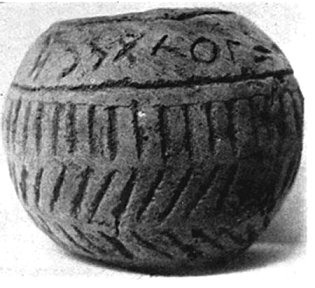
The writing on the tablets remains an enigma. Many claims are offered,
not very conclusively: Basque, Chaldean, Eteocretan, Hebrew, Iberian,
Latin, Berber, Ligurian, Phoenician and Turkic23|.
This author would
probably be labeled 'fringe' if he claimed it was 'Proto-Phoenician'.
Sumerian scripts [pre-3,000 BCE were in cuneiform characters, which
were pronounced syllabically; Egyptian scripts [ca. 3,000 BCE] are
hieroglyphic characters, also pronounced syllabically. Phoenician [or
Proto-Canaanite, ca.1050 BCE], or later Canaanite/Semitic, are true
alphabets and currently considered the first known alphabetic
characters.
If the Glozel tablets were to predate Phoenician they could constitute
the earliest alphabet then known to exist. If such script were to be
dated to, say, 17,000 years ago [15,000 BCE] the consequence would have
momentous implications. Obviously such claims would have to be
rigorously defended, and critics are unlikely to approach the end
result without trepidation.
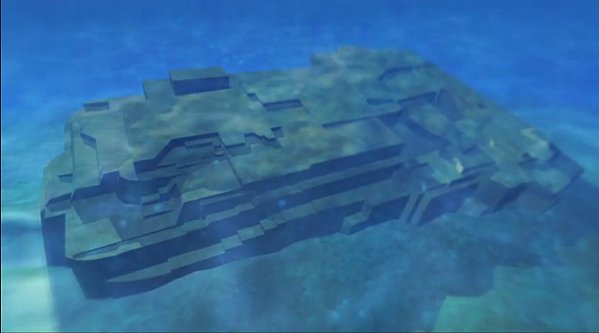
Artist's representation
of ambiguous under-
water formations at
Yonaguni, Japan.
Picture taken from
The History Channel
The Far East enters the pre-history debate with a huge underwater
curiosity off the coast of Yonaguni,
southern Japan. Called the
'Yonaguni Underwater Formation' it is a massive underwater layered rock
formation. At a depth of 75 feet it is hotly debated whether the site
is a natural formation or an ancient 'temple monument'. The structure
measures approximately 490 feet by 130 feet and about 90 feet tall, the
top being about 16 feet below the surface of the ocean. Apparently the
stones are not 'assembled' as a pyramid or ziggurat, but rather
possibly carved out of the underlying rock, which is a very fine
sandstone of the Lower Miocene Yaeyama Group, deposited about 20
million years ago.
The 'monument' consists of a complex series of terraces and broad
steps, mostly rectangular, bounded by near vertical walls. The debate
centers around whether the site is completely natural, is a natural
site that has been modified, or is a man-made artifact. Diving
investigators claim to see 'pillars', two, close together, that rise to
within 8 feet of the surface; a 'totem', a stone column about 23 feet
tall; a low star-shaped platform called the 'Turtle'; a triangle-shaped
pool with two large depressions at its edge; and a 'loop road', a 16
foot wide terrace that circumnavigates the base of the structure on
three sides24|.
If the site has been worked by humans, it would most likely have to
have been prior to the end of the last ice age [ca. 11,000 BCE], when
ocean levels were much lower due to trapped water in the ice.
Geologist Robert Schoch of Boston University believes it is mainly a
natural formation, although possible worked some by humans. He points
out that it occurs in a natural earthquake zone, and earthquakes tend
to fracture rocks in a regular somewhat geometric pattern25|.
Mentioning Dr. Robert Schoch reminds this author how the geologist
'threw a fox into the henhouse' of Egyptologists concerning the Great
Sphinx of Egypt. For centuries the head of the Sphinx stuck out of
the
desert sands of the Giza Plateau. In recent times it was decided to
excavate around the Sphinx and uncover the buried body. Today we see
not only the head but the lion's body and long forearms with a granite
slab, known as the Dream Stele, placed by the young Thutmose IV
(1401–1391 or 1397–1388 BCE) upon the first known excavation of the
front paws.
Upon uncovering the body a puzzling enigma presented itself: severe
erosion, especially water erosion. Dr. Schoch describes the damage
thus, 'Precipitation-induced weathering is seen on the body of the
Sphinx and in the ditch or hollow in which it is situated. This gives a
rolling and undulating vertical
profile to the weathered rocks and is
very well-developed and prominent within the Sphinx enclosure26|.'
[emphasis added by this author]
The Sphinx is dated by Egyptologists as having been built during the
reign of the pharaoh Khafra (ca. 2558–2532 BC). We pointed out above
concerning Nabta Playa that the last rainy period in the Egyptian
desert region was 8,000 to 10,000 BCE. Obviously the two dates are
incompatible and have caused controversy.
In the Bolivian Andean Altiplano south of Lake Titicaca at an elevation
of 13,000 feet and near La Paz lies Puma Punku. The site presents
enigmas that will likely cause controversy for the foreseeable future.
Carbon dating has placed the earliest age of the site as approximately
500 CE. Professor Arthur Posnansky (1873 - 1946), engineer,
entrepreneur and La Paz city council member, spent half his lifetime
studying and writing about Tiahuanaco and neighboring Puma Punku. He is
respected as an avocational archaeologist. Using some of the principles
of archeoastronomy he dates the site to at least 10,000 years old27|.
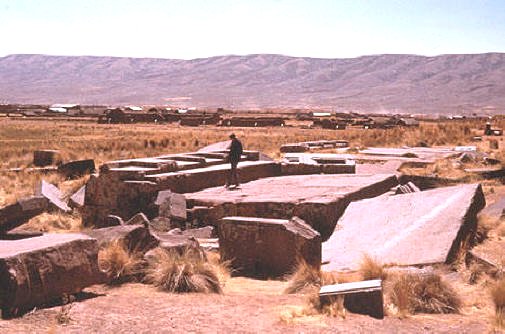
This picture of Puma Punku
[Gate of the Puma] was
taken by Clark Erickson and
shows both the large size of
some of the stones as well as
how scattered the debris
appears.
The enigmas of Puma Punku are not limited to its age, however. The
stones strewn around the destroyed site present unsolvable puzzles. One
stone slab of the 'Plataforma Lítica' is estimated to weigh 131
metric tons. Some of the stones have a polished surface; microscopic
examination has shown that the smooth surfaces could not be duplicated
today without some minor flaws appearing due to laser burning or
scratches scribed by circular diamond cutting wheels. Furthermore, some
of the stones have a precision-made 6 mm wide groove, precise width and
depth lengthwise, which contains equidistant drilled holes along and
within the indentation.

This author cropped and
enhanced
this picture from Wikipedia;
it shows
the straight narrow groove cut into
the hard stone at Puma Punku and
the equidistant holes drilled inside
of the groove.
The picture is credited by Wikipedia
to Matt Corbitt
Some of the 'building blocks' have a dovetailed tongue-in-groove
configuration allowing them to be inseparably interconnected. There are
receding rectilinear indentations in many of the blocks [rabbets], and
they are all so perfectly duplicated as to be considered 'mass
produced'. Engineers say such stone shaping could only be done today
with computer-controlled cutting instruments.
Many stones have bow-tie shaped grooves on the edge of their surfaces
for strapping blocks together. These 'clamps' are metal composed of an
unusual alloy – 95.15% copper, 2.05% arsenic, 1.70% nickel, 0.84%
silicon and 0.26% iron.. The most likely reason for these clamps and
the tongue-in-groove dovetail constructs is to strengthen the
structures against earthquakes, which would likely have been prodigious
in the region over time28|.
Nowhere in the world is there any evidence of such advanced stone work
and architecturally designed structural strength before modern times,
at least known to this author. The site is high on the Altiplano where
there are no trees for 'rolling logs'. In fact, supporting the large
'primitive' population it would have required for construction with
food and shelter would have been quite a challenge.
Yet, despite this incredible planning, the site was destroyed, some say
by earthquake, some by tidal wave from Lake Titicaca or a world-wide
flood. Some of the building stones that needed at least tools of
diamond hardness to carve them were shattered into pieces. All over the
site, according to some observers, are pieces of carved stone shattered
and broadcast over a wide area; one explanation of this mystery is the
intrusion of a large meteorite.
There is no evidence of any written records to help ascertain who the
builders were or when they lived. Indeed, how did they 'mass produce'
so many duplicate stone blocks without any blueprints or
specifications? To date, there is no way of knowing the anwers to such
questions.
History: As We Imagine It
No discussion of early civilized history and pre-historic civilizations
can be complete without some mention of Atlantis. In 360 BCE the Greek
writer, Plato, mentioned the early otherwise undocumented pre-historic
civilization in Timaeus and
in Critias29|.
Modern concepts of Atlantis
as a technologically advanced culture may be biased by modern
interpretations by various commentators. Plato wrote of the Atlanteans
as a militaristic culture from 'beyond the Pillars of Hercules' seeking
to subjugate Europe and Africa. He does detail some of their
architectural creativity.
Nor does Plato claim first hand knowledge of his subject. He claims to
have learned it from Solon, an Athenian lawgiver in the 6th century
BCE, who visited Egypt and was shown a pillar [or papyrus] full of
Hieroglyphs that were translated for him as the story of the ancient
Atlantis continent and its war with the Athens city-state [?]. There
has been scepticism about Plato's story almost from the beginning.
Whether Atlantis existed or not, and whether it was technologically
advanced, really need not impinge upon our present discussion: the
misuse or suppression of difficult historical data.
—————————————————————————————————
[All web links acquired in Spring
of 2014]
1| Quoted in: B. K. Hall, B. Hallgrímsson, eds.; Strickberger's Evolution (4th ed.);
Jones & Bartlett, p. 14; 2008.
2| ibid, p. 41.
3| Nicolas Grimal, A History of
Ancient Egypt; Blackwell Books, 1992.
4| Raymond Allchin, (ed.), The
Archaeology of Early Historic South Asia: The Emergence of Cities
and States,
New York: Cambridge University Press, 1995.
5| James Q. Jacobs, "Mesoamerican
Archaeoastronomy: A Review of Contemporary Understandings of
Prehispanic
Astronomic Knowledge"; Mesoamerican Web Ring:
http://www.jqjacobs.net/mesoamerica/meso_astro.html
6| The Dresden Codex quoted
in Michael Finley, "The Correlation Question"; The Real Maya
Prophecies:
Astronomy in the Inscriptions and Codices; Maya Astronomy
http://web.archive.org/web/20061207090102/http://members.shaw.ca/mjfinley/corr.html
7| Anthony Aveni, The End of Time:
The Maya Mystery of 2012; University Press of Colorado, Boulder;
2009.
8| Ruth H. Shady, Winnifred J. Creamer, 'Dating Caral, a Pre-ceramic
Site in the Supe Valley on the
Central Coast of Peru', Science; 292:723-726, (2001).
9| Willy Hartner, "Al-Battānī, Abū ʿAbd Allāh Muḥammad Ibn Jābir Ibn
Sinān al-Raqqī al-Ḥarrānī al–Ṣābi";
Dictionary
of Scientific Biography, New York: Charles Scribner's Sons;
(1970–80). Also see
http://www.encyclopedia.com/doc/1G2-2830900300.html
10| ibid
11| R.M. Sinclair, "The Nature of Archaeoastronomy"". In Todd W.
Bostwick and Bryan Bates, Viewing
the Sky
Through Past and Present Cultures; Selected Papers from the Oxford VII
International
Conference
on Archaeoastronomy; Pueblo Grande Museum Anthropological
Papers, 15; City of
Phoenix Parks and Recreation Department, pp.
13–26; (2006).
12| J. A. Belmonte, "On the Orientation of Old Kingdom Egyptian
Pyramids"; Archaeoastronomy:
Supplement
to the Journal for the History of Astronomy 32 (26): S1–S20;
2001.
13| Graham Hancock, Fingerprints of
the Gods; New York: Three Rivers Press, p. 168; 1996.
14| E. MacKie, Science and Society
in Prehistoric Britain; Paul Elek; 1977.
15| Clive Ruggles, Michael Hoskin, "Astronomy Before History". In
Michael Hoskin volume, The
Cambridge
Concise History of Astronomy; Cambridge: Cambridge University
Press, 1999; p. 6.
16| A. Sofaer, ed.; Chaco Astronomy:
An Ancient American Cosmology; Santa Fe, New Mexico: Ocean
Tree Books; 2008.
17| Fred Wendorf, J. McKim Malville, "The Megalith Alignments"; in Holocene Settlement of the
Egyptian
Sahara, vol. I, pp. 489–502 (2001).
18| Thomas G. Brophy, Ph.D., The
Origin Map: Discovery of a Prehistoric, Megalithic, Astrophysical
Map and
Sculpture of the Universe, p. 19; Universe, 2002.
19| Ibid.
20| Steven Mithen, After the Ice: A
global human history, 20,000-5000 BC., p. 66; Harvard University
Press, Cambridge MA, 2004.
21| Obituary of Emile Fradin, The
Telegraph, 04 Mar, 2010. See at:
http://www.telegraph.co.uk/news/obituaries/science-obituaries/7370099/Emile-Fradin.html
22| Ibid. The news story has
a fairly precise but complete accounting.
23| Alice Gerard; see: http://www.glozel.net/pdf/The_Glozel_Writing.pdf
24| Ancient Discoveries: Lost Cities
of the Deep, History Channel, season #4, episode #1; Jan 2008.
25| Robert Schoch, An Enigmatic
Ancient Underwater Structure off the Coast of Yonaguni Island, Japan;
1999; See: http://www.robertschoch.net/Enigmatic Yonaguni
Underwater RMS CT.htm
26| Dr. Robert M. Schoch, J.A. West, Redating the Great Sphinx of Giza,
Egypt; Geological Society of
America,
abstracts with programs 25:5 (1991). Also see: Redating the Great Sphinx of Giza,
(1992):
http://www.robertschoch.net/Redating the Great Sphinx
of Giza.htm
27| Arthur Posnansky, Tihuanacu, the
Cradle of American Man, Vols. I - II (Translated into English
by James F. Sheaver), J.J. Augustin, 1945.
28| Jean-Pierre Protzen, Stella E. Nair, On Reconstructing Tiwanaku Architecture;
Journal of the
Society of Architectural Historians, Vol. 59,
No. 3 (Sep., 2000), pp. 358-371; published by:
University of California Press; view at: http://www.scribd.com/doc/89857184/991648
29| There is one earlier account by historical story teller Hellanicus
of Lesbos [490-405 BCE] titled
Atlantis;
only a few fragments survive. It is apparently a genealogical tale of
the daughters of Atlas;
atlantis
in Greek means 'of Atlas'. Some scholars believe that Hellanicus
derived his tale from an
unknown earlier work; see John V Luce, (S.
Casey Fredericks, J. Rufus Fears, Dorothy B. Vitaliano,
Herbert E. Wright Jr.), "The Literary
Perspective"; Atlantis, Fact or
Fiction?; Edwin S. Ramage, ed.;
Indiana University Press, p. 72; 1978.












